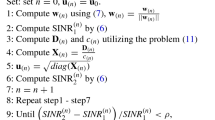Abstract
Transmit diversity multiple-input multiple-output (MIMO) radars decorrelate target echoes on distributed transmit array, and then through closely spaced receivers array estimate the angles of multiple targets using the received target echoes without separating transmitted signals. In this paper, the target echoes correlation is analyzed under Swerling I and II target model assumptions. The results show that: (1) Target echoes are uncorrelated under Swerling II model; (2) under Swerling I model, in order to decrease the correlation of target echoes by increasing the number of transmitters, it is required that the normalized covariance matrices of the signals before and after the transmitter number increases should satisfy a relation given in this study. Finally, the results are verified by computer simulations of the target echoes correlation and angles estimation performance.
Similar content being viewed by others
References
Rabideau D J, Parker P. Ubiquitous MIMO multifunction digital array radar. In: Matthews M B, ed. Conf Record of the 37th Asilomar Conf on Signals, Systems and Computers. New York: The Printing House, 2003. 1057–1064
Sheikhi A, Zamani A. Coherent detection for MIMO radars. In: 2007 IEEE Radar Conf. Boston, MA USA. 2007. 302–307
Fishler E, Haimovich A, Blum R S, et al. Spatial diversity in radars-models and detection performance. IEEE Trans Signal Process, 2006, 54: 823–838
Dai X Z, Peng Y N, Tang J. Detection performance of MIMO radar (in Chinese). J Tsinghua Univ (Sci Tech), 2007, 47: 88–91
Bekkerman I, Tabrikian J. Target detection and localization using MIMO radars and sonars. IEEE Trans Signal Process, 2006, 54: 3873–3883
Lehmann N H, Fishler E, Haimovich A M, et al. Evaluation of transmit diversity in MIMO-radar direction finding. IEEE Trans Signal Process, 2007, 55: 2215–2225
Li J, Stoica P. MIMO radar with colocated antennas. IEEE Signal Process Mag, 2007, 24: 106–114
Wang D, Zhang L, Wu Y. The structured total least squares algorithm research for passive location based on angle information. Sci China Ser F-Inf Sci, 2009, 52: 1043–1054
Sheng Z, Xie S Q, Pan C Y. Probability and Statistical (in Chinese). 2nd ed. Beijing: Higher Education Press, 2001. 350–351
Seber G A F. A Matrix Handbook for Statisticians. New Jersey: Wiley, 2007. 434–435
Zhang X D. Matrix Analysis and Application (in Chinese). Beijing: Tsinghua University Press, 2004. 44–46
Tian Z. Iterative MUSIC: coherent signal estimation, performance analysis. In: Mercer B, ed. Proc IEEE International Conf on Acoustics, Speech and Signal Process. New York: The Printing House, 2002. 3041–3044
Pillai U S, Kwon B H. Performance analysis of MUSIC-type high resolution estimators for direction finding in correlated and coherent scenes. IEEE Trans Acoust Speech Signal Process, 1989, 37: 1176–1189
Author information
Authors and Affiliations
Corresponding author
Rights and permissions
About this article
Cite this article
Jin, M., Liao, G. & Li, J. Correlation analysis of target echoes using distributed transmit array. Sci. China Inf. Sci. 53, 1860–1868 (2010). https://doi.org/10.1007/s11432-010-4050-5
Received:
Accepted:
Published:
Issue Date:
DOI: https://doi.org/10.1007/s11432-010-4050-5




